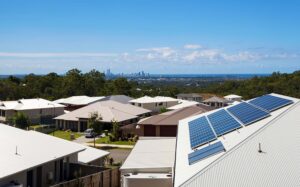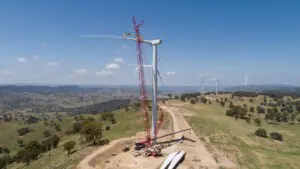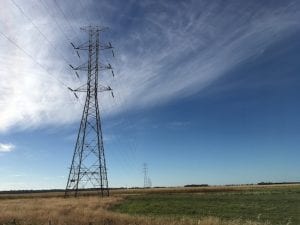One of Australia’s leading renewable energy chiefs – a former gas executive – has broken ranks within the industry and argued that government will have to support new gas peaking generators in the main grid, or else they will simply not be built.
Gas has emerged as a central talking point in the election battle over energy policies, and while there is general agreement that less gas will be burned for electricity in coming years, there is a recognition among most that it will be essential when needed.
Gas has been excluded from the federal government’s Capacity Investment Scheme and most state equivalents – which at the urging to the renewables industry are focused towards battery storage and the more problematic (because of costs, timelines and planning approvals) pumped hydro.
The one exception is South Australia, ironically the state with the most wind and solar (72 per cent) and with a growing number and influence of battery storage, with five big batteries in operation and another eight on their way. See: South Australia may underwrite gas generators in new plan to back up 100 pct net renewables target
The Federal Coalition wants to put gas into the CIS, but most in the industry say the reality is that it won’t be able to compete with battery storage without tilting the rules massively in its favour. The suggestion now is that maybe a different sort of mechanism is needed because new peaking gas generators won’t get built otherwise.
Gas has always been the most expensive generation on Australia’s main grid (apart from the rarely used diesel), but its problems have been compounded by the fact that the cost of building gas generators has trebled in recent years, and even buying a turbine in any near term timeframes would be difficult because not enough are being built.
“The reality is that you can’t buy a gas turbine for the next four to five years,” David Scaysbrook, the founder and co-head of Quinbrook Infrastructure Investors, one of the world’s biggest energy investors, told Renew Economy recently in an episode of the popular Energy Insiders podcast.
“They’re all sold out,” he says. And the price has also soared. “They are nearly four times the cost of what it was two years ago.” See: You want to build a gas fired power station before 2030? Good luck with that
Australia does not need much more gas capacity than it does now, even as renewables soar to the targeted share of 82 per cent by 2030.
But the Australian Energy Market Operator says much of the existing portfolio is old and unreliable, and will need to be replaced. Even though these gas generators may only be needed for a few days a year, they will be essential to maintain grid reliability, it says.
Anthony Fowler, the CEO of Tilt Renewables, and a former head of generation (coal, gas and renewables) at AGL and CEO of gas storage company Lockhard, says there are four big problems – the cost of building gas, the cost of burning gas, the cost of gas infrastructure, and the fact that few customers wants to write contracts for burning fossil fuels.
“I tried twice to build gas generators at companies which both had huge reasons to do so. And I could never find a business case to get it done,” Fowler told the Clean Energy Investors Forum in Sydney last week.
Fowler says the rising cost of gas – it is about three times higher than it was a decade ago – has made the business case even more complicated. Investors also worry about their fossil fuel footprint. An even bigger problem is being able to store the gas.
“There are very few places you can build these things, and then you have to store it. So it’s very, very hard to put together a commercial business case. No one’s done it in recent times.”
Fowler points out that EnergyAustralia recently completed the Tallawarra B facility in NSW, but that project overcame its hurdles because it was an expansion of an existing gas generation facility, and it got significant financial backing from the NSW government.
Snowy Hydro is also building the Kurri Kurri gas generator in the Hunter Valley, but that is entirely government funded and highlights many of the problems cited by Fowler and others, and is running into major problems on costs and delays.
Fowler says, however, that new gas generation – at least to replace some the existing fleet that is running to the end of its life – is essential.
“Working at that big gentailer (AGL) years ago, running their trading books for many years, I’ve been bashed by every type of damn weather condition: Too hot, too cold, not enough wind, water, whatever,” Fowler said.
“A renewables based system needs far more deep storage that I think we’ve gotten our heads around, I think in time, facilities like Hydrostor (the policy head of the compressed air storage developer was sitting next to him) will help a great deal. But this is not a one hour problem or four hour problem or one day or two days.
“This is potentially months of low wind conditions or months of hydro, and I just don’t think that we have the resilience in our system to be able to support it with the technology that we have today.
“So, more has to be built. It needs to be very, very carefully supported. Very likely, underwritten by government.” He even suggests that it should be put into the CIS “in some form”, but that seems unlikely given it would require the approval of parliament, and that is not likely to happen.
Fowler insists that something needs to be done, even if it is for the short term. “You’ve got to know that this is a band aid to help us through,”. It’s not going to be around forever, because otherwise, who’s going to put the hard work into developing, you know, the next generation of big storage?
“But I think it’s an important stop gap for a time, as we’re learning to live with primarily a renewable based system.”
Hydrostor’s Scott Bolton was less convinced, noting that gas support would go against the last 10 years of policy evolution, although he conceded that it could be used as a “break glass in case of emergency” asset. Hydrostor is building its first large compressed air storage facility near Broken Hill.
“There is a role, there is a government obligation, to ensure that ultimate last line of reliability, and do so in a way that allows the rest of the policy momentum and investment that has been underway.”
Dennis Freedman, the head of Aquila Clean Energy, agreed that gas could not and should not be shoe-horned into the existing CIS. “I think an eight hour battery would shoot the lights out in a tender versus any gas peaker.”








